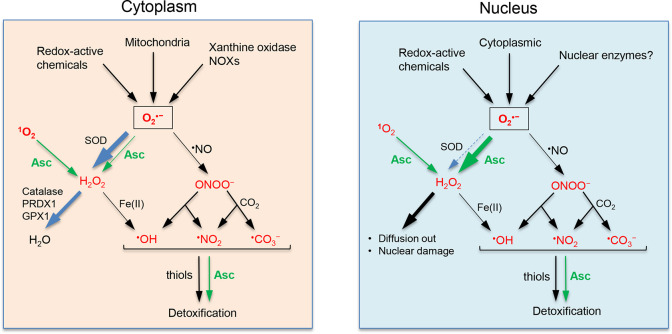Figure 2.
Main cellular ROS and antioxidant mechanisms. Superoxide anion radical (O2•–) is the primary ROS produced by various physiological and pathophysiological processes. Reduction of O2•– by SODs or ascorbate (Asc) produces a less reactive but more diffusible H2O2 which is detoxified by catalase, peroxiredoxin 1 (PRDX1), and glutathione peroxidase 1 (GPX1). Reaction of H2O2 with free Fe(II) and less frequently Cu(I) yields a highly damaging •OH radical. Hydroxyl and other reactive radicals are also formed during the decomposition of peroxynitrite generated in the reaction of nitric oxide radical (•NO) with O2•–. In comparison with the biological processes, ascorbate makes no significant contribution to the detoxification of H2O2 and plays a minor role in the removal of cytoplasmic O2•– in the majority of cells. Secondary radicals (tertiary ROS) arising from H2O2 and ONOO– lack specialized enzymatic defenses and are primarily detoxified by small antioxidants such as ascorbate and small thiols (glutathione). Cells also lack enzymatic processes for removal of singlet oxygen (1O2) which is effectively eliminated by ascorbate via a two-electron reduction to H2O2. In contrast to the cytoplasm, the nucleus has a minimal or no SOD activity, which elevates the importance of ascorbate in scavenging superoxide in this cellular compartment.

